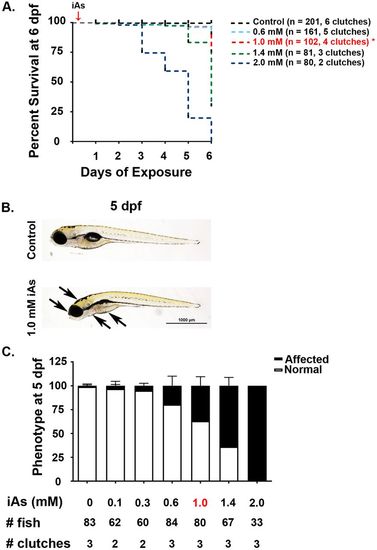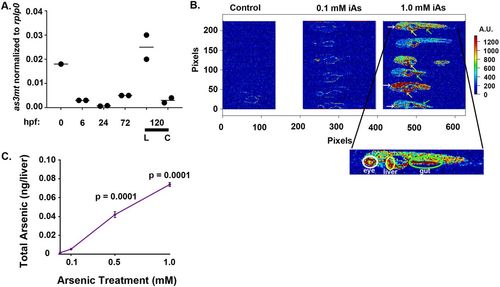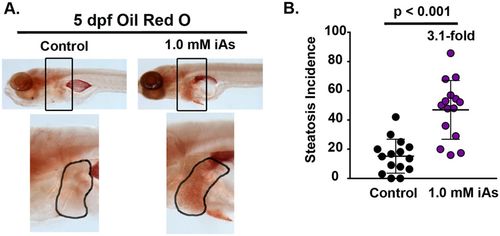- Title
-
Inorganic arsenic causes fatty liver and interacts with ethanol to cause alcoholic liver disease in zebrafish
- Authors
- Bambino, K., Zhang, C., Austin, C., Amarasiriwardena, C., Arora, M., Chu, J., Sadler, K.C.
- Source
- Full text @ Dis. Model. Mech.
|
Exposure to iAs is toxic to zebrafish embryos. (A) Survival analysis of zebrafish treated with iAs from 4 hpf through 6 dpf. Fish were scored daily for mortality (n≥2 clutches, >80 embryos per condition, Table S1). Red arrow indicates addition of iAs. Concentration of iAs used throughout the manuscript is shown in red and indicated by an asterisk. (B) Bright-field images of representative wild-type control (top) and arsenic-exposed (bottom) 5 dpf zebrafish larvae. Arrows indicate arsenic-induced phenotypes, including shortened body length, edema, clustering of pigment cells, under-consumption of yolk, and a small head. (C) Exposure to increasing doses of iAs from 4 hpf to 5 dpf led to an accumulation of phenotypes. The proportion of surviving embryos at 5 dpf that were affected increased with increasing concentrations of iAs (n=2 clutches exposed to 0.1 mM or 0.3 mM, n=3 clutches exposed to 0.6 mM, 1.0 mM or 1.4 mM, >30 fish exposed per treatment condition, Table S1). hpf, hours post-fertilization; dpf, days post-fertilization; iAs, inorganic arsenic. |
|
Zebrafish are capable of arsenic metabolism and accumulate iAs in their tissues. (A) Expression of the zebrafish as3mt transcript is dynamic during zebrafish development, as determined by qRT-PCR. as3mt is maternally provided. Expression is enriched in the liver at 120 hpf. Error bars correspond to mean±s.d. L, liver; C, carcass. (B) Representative images of LA-ICP-MS analysis of 10-μm sections of control and iAs-exposed larvae. Following exposure from 4 to 120 hpf, iAs accumulated in the eye (white arrows, white circle in enlarged image), liver (yellow arrows, yellow circle in enlarged image) and in the gut (green arrows, green circle in the enlarged image). Refer to Table S2 for operating parameters. (C) Quantification of total arsenic content in the livers of 5-dpf larvae by ICP-MS. Livers dissected from larvae exposed to 0, 0.1, 0.5 and 1.0 mM iAs from 4 to 120 hpf showed a dose-dependent increase in the total arsenic content per liver (n=3 clutches). Error bars correspond to mean±s.d. hpf, hours post-fertilization; LA-ICP-MS, laser-ablation–inductively-coupled-plasma–mass-spectroscopy; iAs, inorganic arsenic; ICP-MS, inductively-coupled-plasma–mass-spectroscopy. |
|
Exposure to iAs causes steatosis in zebrafish larvae. (A) Representative bright-field images of 5-dpf Oil Red O (ORO)-stained control and iAs-exposed (1.0 mM from 4 to120 hpf) larvae. The area around the liver (outlined in black) is enlarged. (B) The percent of larvae with steatosis analyzed by ORO staining of 15 clutches, with an average of 20 larvae per treatment per clutch. The total number of larvae analyzed in each clutch is listed in Table S1. Statistical significance was determined by unpaired, 2-tailed Student's t-test (n=15 clutches, P<0.001, Table S1). Error bars correspond to mean±s.d. PHENOTYPE:
|

ZFIN is incorporating published figure images and captions as part of an ongoing project. Figures from some publications have not yet been curated, or are not available for display because of copyright restrictions. |



